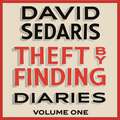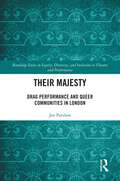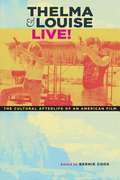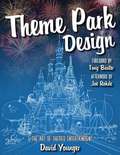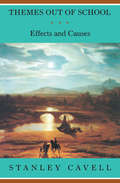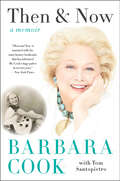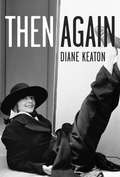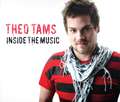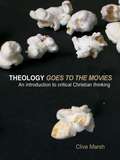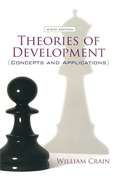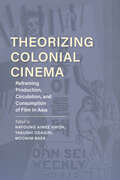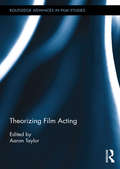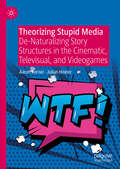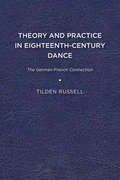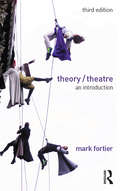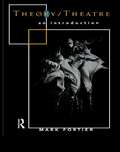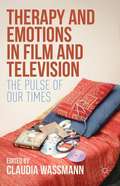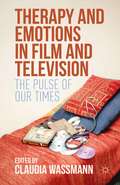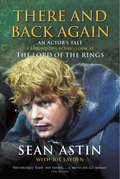- Table View
- List View
Theft by Finding: Diaries: Volume One
by David SedarisTHE NEW YORK TIMES BESTSELLER'He's like an American Alan Bennett, in that his own fastidiousness becomes the joke, as per the taxi encounter, or his diary entry about waiting interminably in a coffee-bar queue' Guardian review of An Evening with David SedarisThe point is to find out who you are and to be true to that person. Because so often you can't. Won't people turn away if they know the real me? you wonder. The me that hates my own child, that put my perfectly healthy dog to sleep? The me who thinks, deep down, that maybe The Wire was overrated?For nearly four decades, David Sedaris has faithfully kept a diary in which he records his thoughts and observations on the odd and funny events he witnesses. Anyone who has attended a live Sedaris event knows that his diary readings are often among the most joyful parts of the evening. But never before have they been available in print. Now, in Theft by Finding, Sedaris brings us his favorite entries. From the family home in Ralegh, North Carolina, we follow Sedaris as he sets out to make his way in the world. As an art student and then teacher in Chicago he works at a succession of very odd jobs, meeting even odder people, before moving to New York to pursue a career as a writer - where instead he very quickly lands a job in Macy's department store as an elf in Santaland... Tender, hilarious, illuminating, and endlessly captivating, Theft by Finding offers a rare look into the mind of one of our generation's greatest comic geniuses.
Their Majesty: Drag Performance and Queer Communities in London (Routledge Series in Equity, Diversity, and Inclusion in Theatre and Performance)
by Joe ParslowThis book explores drag performance in London since 2009 via the pubs, bars and clubs that make LGBTQ+ communities thrive.It studies the complex relationship between drag performance, LGBTQ+ venues and queer communities. In exploring drag performance, the book develops a greater understanding of the connection between drag performance and queer communities, in particular exploring how drag might facilitate queer communities and offer queer modes of survival and resistance for queer people. Through this, the book describes a contemporary moment in which drag performance is increasingly popular and increasingly important at a time when homophobic and transphobic violence is prevalent, and LGBTQ+ venues are often under threat of closure. Understanding the increased/increasing mainstream popularity of drag, the book examines drag performance that is connected to and resists mainstream attention in order to account for its complexity in London (and beyond).This book takes the author’s engagement with and love for drag and exerts a critical, political and queer pull in order to develop new terrains of queer studies and queer performance studies.
Thelma & Louise Live!
by Bernie CookWhen they floored their Thunderbird off a cliff rather than surrender to the law, Thelma and Louise became icons of female rebellion, provoking strong reactions from viewers who felt either empowered or outraged by the duo's transgressions of women's traditional roles. The 1991 film quickly became--and continues to be--a potent cultural reference point, even inspiring a bumper sticker that declares, "Thelma & Louise Live!" In this insightful study of Thelma & Louise, six noted film scholars investigate the initial reception and ongoing impact of this landmark film. The writers consider Thelma & Louise from a variety of perspectives, turning attention to the film's promotion and audience response over time; to theories of comedy and the role of laughter in the film; to the film's soundtrack and score; to the performances of stars Susan Sarandon and Geena Davis; to the emergence of Brad Pitt as a star and male sex object; and to the film's place in the history of road and crime film genres. Complementing the scholarly analysis is an in-depth interview of screenwriter Callie Khouri by editor Bernie Cook, as well as reviews of Thelma & Louise that appeared in U. S. News & World Report and Time. Offering myriad new ways of understanding the complex interrelations of gender, identity, and violence, Thelma & Louise Live! attests to the ongoing life and still-evolving meanings of this now-classic film.
Theme Park Design and the Art of Themed Entertainment
by David YoungerWant to design a theme park? Over the past century, theme parks have created worlds where pirates still loot Caribbean towns, where daring adventurers explore booby-trapped temples, and where superheroes swing from New York skyscrapers - and allowed us to step into them too. This is a book about how to design those fantastic places, and the ingenuity that goes into their creation. This is a handbook for the practicing designer, a textbook for the aspiring student, and a behind the scenes guidebook for the theme park fan, building on hundreds of interviews with accomplished designers from Walt Disney Imagineering, Universal Creative, Merlin Entertainments, and more. Theme Park Design & The Art of Themed Entertainment explores everything from the stories, themes, and characters that theme parks bring to life, to the business models, processes, and techniques that allow them to do it. From rocket ships to roller coasters, fairy tales to fireworks, and dinosaurs to dark rides, never before has a book dived so deep into the art form of themed entertainment.
Themes Out Of School: Effects and Causes
by Stanley CavellIn the first essay of this book, Stanley Cavell characterizes philosophy as a "willingness to think not about something other than what ordinary human beings think about, but rather to learn to think undistractedly about things that ordinary human beings cannot help thinking about, or anyway cannot help having occur to them, sometimes in fantasy, sometimes as a flash across a landscape. " Fantasies of film and television and literature, flashes across the landscape of literary theory, philosophical discourse, and French historiography give Cavell his starting points in these twelve essays. Here is philosophy in and out of "school," understood as a discipline in itself or thought through the works of Shakespeare, Molière, Kierkegaard, Thoreau, Brecht, Makavejev, Bergman, Hitchcock, Astaire, and Keaton.
Then & Now: A Memoir
by Tom Santopietro Barbara CookOne of the greatest American singers and actresses of her generation looks back on a magical and turbulent life spanning a half century of theatrical history from the golden age of the Broadway musical to the present day.A legend of the American theater, Barbara Cook burst upon the scene to become Broadway’s leading ingénue in roles such as Cunégonde in Leonard Bernstein’s Candide, Amalia Balash in Jerry Bock’s She Loves Me, and her career-defining, Tony-winning role as the original Marian the librarian in Meredith Willson’s The Music Man. But in the late 1960s, Barbara’s extraordinary talent onstage was threatened by debilitating depression and alcoholism that forced her to step away from the limelight and out of the public life. Emerging from the shadows in the early 1970s, Barbara reinvented herself as the country’s leading concert and cabaret artist, performing the songs of Stephen Sondheim and other masters, while establishing a reputation as one of the greatest and most acclaimed interpreters of the American songbook.Taking us deep into her life and career, from her childhood in the South to the Great White Way, Then and Now candidly and poignantly describes both her personal difficulties and the legendary triumphs, detailing the extraordinary working relationships she shared with many of the key composers, musicians, actors and performers of the late twentieth century, among them Sondheim, Leonard Bernstein, Elaine Stritch, and Robert Preston.Hailed by the Financial Times of London as "the greatest singer in the world", but preferring to think of herself as "a work in progress", Barbara Cook here delivers a powerful, personal tale of pain and triumph, as straight forward, unflinchingly honest, and open hearted as her singing.
Then Again
by Diane Keaton"Mom loved adages, quotes, slogans. There were always little reminders pasted on the kitchen wall. For example, the word THINK. I found THINK thumbtacked on a bulletin board in her darkroom. I saw it Scotch-taped on a pencil box she'd collaged. I even found a pamphlet titled THINK on her bedside table. Mom liked to THINK." So begins Diane Keaton's unforgettable memoir about her mother and herself. In it you will meet the woman known to tens of millions as Annie Hall, but you will also meet, and fall in love with, her mother, the loving, complicated, always-thinking Dorothy Hall. To write about herself, Diane realized she had to write about her mother, too, and how their bond came to define both their lives. In a remarkable act of creation, Diane not only reveals herself to us, she also lets us meet in intimate detail her mother. Over the course of her life, Dorothy kept eighty-five journals--literally thousands of pages--in which she wrote about her marriage, her children, and, most probingly, herself. Dorothy also recorded memorable stories about Diane's grandparents. Diane has sorted through these pages to paint an unflinching portrait of her mother--a woman restless with intellectual and creative energy, struggling to find an outlet for her talents--as well as her entire family, recounting a story that spans four generations and nearly a hundred years. More than the autobiography of a legendary actress, Then Again is a book about a very American family with very American dreams. Diane will remind you of yourself, and her bonds with her family will remind you of your own relationships with those you love the most.
Thendral: Vol. 14, Issue 03, February 2014
by MadhurabharathiThis issue features interviews with veterans Padmashree S.M.Ganapathy Sthapathy, Madurai G.S.Mani, mouth-watering recipes, homage to many veterans, short stories,an article on 37th book fair and other usual features like Ilanthendral , Kathiravanai Kelungal, Nalam Vaazha etc.
Thendral: Vol. 14, Issue 04, March 2014
by MadhurabharathiThis issue features an interview with Dr.Chithra Vaitheeshwaran, three short stories, article on Mangala Nadha Swami Temple at Uthara kosa Mangai, travelogues on Malaysia and Nepal, an article paying homage to Balu Mahendra and Iravadam R.Swaminathan, an article on the legendary dancer and choreographer Rukmani devi Arundale , mouth watering recipes of Idly varieties, a brain teaser section with Maths puzzles along with usual features like Thendral Pesukirathu; Anbulla Snehitiye,Kathiravanai Kelungal,Nalam Vaazha etc.
Thendral: Vol. 14, Issue 05, April 2014
by MadhurabharathiThis issue features an interview with Kalakshetra’s Director Priyadarshini Govind , two short stories, ‘Payanam’ talks about a visit to Marymoor Park in Washington, ‘Samayam’ features Ayirathen Vinayagar temple, an article paying homage to T.K.Sivasankaran and Kushvanth Singh, mouth watering recipes, an article on Achievers featuring Kuralarasi Geetha Arunachalam and a few other young achievers ,an article on the veteran writer Kumuthini along with usual features like Thendral Pesukirathu ,Kathiravanai Kelungal,Nalam Vaazha, Kavithai Pandhal, Pudhinam and important events of last month.
Theo Tams: Inside the Music
by Craig McConnellAfter a summer of intense competition, Alberta’s Theo Tams emerged as the 2008 Canadian Idol champion. He had earned the admiration of the public and his fellow contestants with his soaring vocals, emotive piano playing and unmatched ability to mine the emotional core of a song. Theo Tams: Inside the Music is a candid and photo-rich look at the life experiences that prepared him for the Idol stage. It also provides a behind the scenes peek at the Idol experience itself, with testimonials and anecdotes from his fellow competitors and interviews with the Idol personalities. Theo Tams: Inside the Music is the first chapter in the career of an exciting new voice from the Canadian music scene. It includes excerpts from Theo’s private journals, adventures from his time in India, anecdotes from his fellow competitors, interviews with Idol personalities such as Ben Mulroney and Zack Werner, hundreds of candid photos and much, much more.
Theology Goes to the Movies: An Introduction to Critical Christian Thinking
by Clive MarshDrawing a comparison between religion and cinema-going, this text examines a range of contemporary films in relation to key theological concepts. Cinema as a religion-like activity is explored through cognitive, affective, aesthetic and ethical levels, identifying the religious aspects in the social practice of cinema-going. Written by a leading expert in the field, Theology Goes to the Movies analyzes: the role of cinema and Church in Western culture the power of Christian symbols and images within popular culture theological concepts of humanity, evil and redemption, eschatology and God. This is an ideal text for students seeking a new way into the study of theology.
Theology and the Films of Terrence Malick (Routledge Studies in Religion and Film)
by Christopher B. Barnett Clark J. EllistonTerrence Malick is one of the most important and controversial filmmakers of the last few decades. Yet his renown does not stem from box office receipts, but rather from his inimitable cinematic vision that mixes luminous shots of nature, dreamlike voiceovers, and plots centered on enduring existential questions. Although scholars have thoroughly examined Malick’s background in philosophy, they have been slower to respond to his theological concerns. This volume is the first to focus on the ways in which Malick integrates theological inquiries and motifs into his films. The book begins with an exploration of Malick’s career as a filmmaker and shows how his Heideggerian interests relate to theology. Further essays from established and up-and-coming scholars analyze seven of Malick’s most prominent films – Badlands (1973), Days of Heaven (1978), The Thin Red Line (1998), The New World (2005), The Tree of Life (2011), To the Wonder (2012), and Knight of Cups (2015) – to show how his cinematic techniques point toward and overlap with principles of Christian theology. A thorough study of an iconic filmmaker, this book is an essential resource for students and scholars in the emerging field of religion and film.
Theorie und Theater: Zum Verhältnis von wissenschaftlichem Diskurs und theatraler Praxis (Kulturelle Figurationen: Artefakte, Praktiken, Fiktionen)
by Astrid Hackel and Mascha VollhardtDie Theaterwissenschaft beruft sich gern auf den gemeinsamen Ursprung von Theorie und Theater. Ein Grund zu fragen, auf welche Weise akademische Diskurse Eingang in zeitgenössische Performances, Tanz- und Theaterinszenierungen finden und was diese umgekehrt zur Vermittlung oder sinnlichen Fremdwerdung theoretischen Wissens beitragen können. Untersucht werden die zahlreichen Verflechtungen und Unwägbarkeiten zwischen Theorie und Theater, die szenische Selbstreferenzialität und Widerständigkeit gegen die eigene Theoretisierbarkeit, die Herausforderungen im Umgang mit humanwissenschaftlichen, (post-)feministischen und queeren Theorien sowie der Stellenwert von Sprache, Sinn und Sinnlichkeit in zeitgenössischen Inszenierungen.
Theories of Development: Concepts and Applications (6th Edition)
by William CrainThis text introduces students to twenty-four theorists and compares and contrasts their theories on how we develop as individuals. Emphasizing the theories that build upon the developmental tradition established by Rousseau, this text also covers theories in the environmental/learning tradition.
Theorizing Art Cinemas: Foreign, Cult, Avant-Garde, and Beyond
by David AndrewsThe term "art cinema" has been applied to many cinematic projects, including the film d'art m ovement, t he p ostwar a vantgardes, various Asian new waves, the New Hollywood, and American indie films, but until now no one has actually defined what "art cinema" is. Turning the traditional, highbrow notion of art cinema on its head, Theorizing Art Cinemas takes a flexible, inclusive approach that views art cinema as a predictable way of valuing movies as "art" movies--an activity that has occurred across film history and across film subcultures--rather than as a traditional genre in the sense of a distinct set of forms or a closed historical period or movement. David Andrews opens with a history of the art cinema "supergenre" from the early days of silent movies to the postwar European invasion that brought Italian Neorealism, the French New Wave, and the New German Cinema to the forefront and led to the development of auteur theory. He then discusses the mechanics of art cinema, from art houses, film festivals, and the academic discipline of film studies, to the audiences and distribution systems for art cinema as a whole. This wide-ranging approach allows Andrews to develop a theory that encompasses both the high and low ends of art cinema in all of its different aspects, including world cinema, avant-garde films, experimental films, and cult cinema. All of these art cinemas, according to Andrews, share an emphasis on quality, authorship, and anticommercialism, whether the film in question is film festival favorite or a midnight movie.
Theorizing Colonial Cinema: Reframing Production, Circulation, and Consumption of Film in Asia (New Directions in National Cinemas)
by Aaron Gerow Zhen Zhang Yiman Wang José B. Capino Nadine Chan Jane Marie Gaines Thomas A. Barker Nikki J. LeeTheorizing Colonial Cinema is a millennial retrospective on the entangled intimacy between film and colonialism from film's global inception to contemporary legacies in and of Asia. The volume engages new perspectives by asking how prior discussions on film form, theory, history, and ideology may be challenged by centering the colonial question rather than relegating it to the periphery. To that end, contributors begin by excavating little-known archives and perspectives from the colonies as a departure from a prevailing focus on Europe's imperial histories and archives about the colonies. The collection pinpoints various forms of devaluation and misrecognition both in and beyond the region that continue to relegate local voices to the margins. This pathbreaking study on global film history advances prior scholarship by bringing together an array of established and new interdisciplinary voices from film studies, Asian studies, and postcolonial studies to consider how the present is continually haunted by the colonial past.
Theorizing Film Acting (Routledge Advances in Film Studies)
by Aaron TaylorThis comprehensive collection provides theoretical accounts of the grounds and phenomenon of film acting. The volume features entries by some of the most prominent scholars on film acting who collectively represent the various theoretical traditions that constitute the discipline of film studies. Each section proposes novel ways of considering the recurring motifs in academic enquiries into film acting, including: (1) the mutually contingent problematic of description and interpretation, (2) the intricacies of bodily dynamics and their reception by audiences, (3) the significance of star performance, and (4) the impact of evolving technologies and film styles on acting traditions.
Theorizing Stupid Media: De-Naturalizing Story Structures in the Cinematic, Televisual, and Videogames
by Julian Hoxter Aaron KernerThis book explores the stupid as it manifests in media—the cinema, television and streamed content, and videogames. The stupid is theorized not as a pejorative term but to address media that “fails” to conform to established narrative conventions, often surfacing at evolutionary moments. The Transformers franchise is often dismissed as being stupid because its stylistic vernacular privileges kinetic qualities over conventional narration. Similarly, the stupid is often present in genre fails like mother!, or in instances of narrative dissonance—joyously in Adventure Time; more controversially in Gone Home— where a story “feels off” It also manifests in “ludonarrative dissonance” when gameplay and narrative seemingly run counter to one another in videogames like Undertale and Bioshock. This book is addressed to those interested in media that is quirky, spectacle-driven, or generally hard to place—stupid!
Theory and Practice in Eighteenth-Century Dance: The German-French Connection (Studies in Seventeenth- and Eighteenth-Century Art and Culture)
by Tilden RussellThis book is about the intersection of two evolving dance-historical realms—theory and practice—during the first two decades of the eighteenth century. France was the source of works on notation, choreography, and repertoire that dominated European dance practice until the 1780s. While these French inventions were welcomed and used in Germany, German dance writers responded by producing an important body of work on dance theory. This book examines consequences in Germany of this asymmetrical confrontation of dance perspectives. Between 1703 and 1717 in Germany, a coherent theory of dance was postulated that called itself dance theory, comprehended why it was a theory, and clearly, rationally distinguished itself from practice. This flowering of dance-theoretical writing was contemporaneous with the appearance of Beauchamps-Feuillet notation in the Chorégraphie of Raoul Auger Feuillet (Paris, 1700, 1701). Beauchamps-Feuillet notation was the ideal written representation of the dance style known as la belle danse and practiced in both the ballroom and the theater. Its publication enabled the spread of belle danse to the French provinces and internationally. This spread encouraged the publication of new practical works (manuals, choreographies, recueils) on how to make steps and how to dance current dances, as well as of new dance treatises, in different languages. The Rechtschaffener Tantzmeister, by Gottfried Taubert (Leipzig, 1717), includes a translated edition of Feuillet’s Chorégraphie. Theory and Practice in Eighteenth-Century Dance addresses how Taubert and his contemporary German authors of dance treatises (Samuel Rudolph Behr, Johann Pasch, Louis Bonin) became familiar with Beauchamps-Feuillet notation and acknowledged the Chorégraphie in their own work, and how Taubert’s translation of the Chorégraphie spread its influence northward and eastward in Europe. This book also examines the personal and literary interrelationships between the German writers on dance between 1703 and 1717 and their invention of a theoria of dance as a counterbalance to dance praxis, comparing their dance-theoretical ideas with those of John Weaver in England, and assimilating them all in a cohesive and inclusive description of dance theory in Europe by 1721. Published by University of Delaware Press. Distributed worldwide by Rutgers University Press.
Theory/Theatre: An Introduction
by Mark FortierTheory/Theatre: An Introduction provides a unique and engaging introduction to literary theory as it relates to theatre and performance. Mark Fortier lucidly examines current theoretical approaches, from semiotics, poststructuralism, to cultural materialism, postcolonial studies and feminist theory. Drawing upon examples from Shakespeare and Aphra Behn, to Chekhov, Artaud, Cixous and Churchill, the author examines the specific realities of theatre in order to come to a richer understanding of the relations between performance and cultural theory. Theory/Theatre: An Introduction is the only study of its kind and will be invaluable reading for new students and scholars of performance studies.
Theory/Theatre: An Introduction
by Mark FortierTheory/Theatre: An Introduction provides a unique and engaging introduction to literary theory as it relates to theatre and performance. Mark Fortier lucidly examines current theoretical approaches, from semiotics, poststructuralism, to cultural materialism, postcolonial studies and feminist theory. Drawing upon examples from Shakespeare and Aphra Behn, to Chekhov, Artaud, Cixous and Churchill, the author examines the specific realities of theatre in order to come to a richer understanding of the relations between performance and cultural theory. Theory/Theatre: An Introduction is the only study of its kind and will be invaluable reading for new students and scholars of performance studies.
Therapy and Emotions in Film and Television: The Pulse Of Our Times
by Claudia WassmannTherapy and Emotions in Film and Television.
Therapy and Emotions in Film and Television: The Pulse of Our Times
by Claudia WassmannTherapy and Emotions in Film and Television explores, from an interdisciplinary perspective, the shifts in our emotional preferences, styles, and 'emotional regimes' in western societies from the 1920s to today, as viewed through the lens of film and television.
There And Back Again: An Actor's Tale
by Joe Layden Sean AstinWhen Sean Astin, veteran Hollywood actor of over 30 movies including The Goonies, and Rudy, landed the part of Samwise Gamgee in The Lord of the Rings, he knew it was going to be different to anything he'd ever worked on before. Here he shares his heartfelt opinions on his early movies, how he got the part of Sam at that point in his career, and what it was like to be on set for nearly two years of his life. How did he and the other cast members get along? What were the excitements and the dangers they faced during filming? What happened the evening that Elijah Wood lost the keys to his room? How did Sir Ian McKellen cope when he didn't like the music the hobbits listened to during make-up and what happened when the crew considered striking?Revealing and immensely readable, There and Back Again is the behind-the-scenes look at what it was like to be involved in the making of one of the biggest movie franchises of all time.
